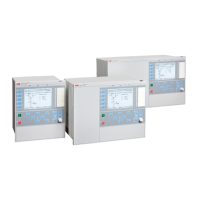The Signal Monitoring in PCM600 shows the same signals that are available on the local
HMI.
The condition for this procedure is that the set value of IMinOp is lower than the set value
of Pickup_Block.
11.9.1.1 Verifying the settings
1. Check the input circuits and the trip value of the IMinOp current level detector by
injecting current, one phase at a time.
2. Check the phase current blocking function for all three phases by injecting current,
one phase at a time. The output signals shall reset with a delay of 1 second when the
current exceeds 1.5 · IBase.
3. Inject a current 0.1 · IBase to the reference current input Analogue channel ID
current input 5.
4. Increase slowly the current in one of the phases and check that FAIL output is
obtained when the current is above 0.9 · IBase.
11.9.1.2 Completing the test
Continue to test another function or end the test by changing the TESTMODE setting to
Disabled. Restore connections and settings to their original values, if they were changed
for testing purposes.
11.9.2 Fuse failure supervision FUFSPVC
Prepare the IED for verification of settings outlined in Section
"Preparing the IED to
verify settings".
The verification is divided in two main parts. The first part is common to all fuse failure
supervision options, and checks that binary inputs and outputs trip as expected according
to actual configuration. In the second part the relevant set trip values are measured.
11.9.2.1 Checking that the binary inputs and outputs trip as expected
1. Simulate normal operating conditions with the three-phase currents in phase with
their corresponding phase voltages and with all of them equal to their rated values.
2. Connect the nominal dc voltage to the 89bS binary input.
Section 11 1MRK 504 165-UUS -
Testing functionality by secondary injection
230 Transformer protection RET670 2.2 ANSI
Commissioning manual

